1. Introduction
Sunflower (Helianthus annuus L.) is a crop with wide adaptability to different edaphoclimatic conditions, since yield is little affected by latitude, altitude and photoperiod [1]. This crop is of short cycle with good characteristics and great potential for the agribusiness of Northeast Brazil, due to its social and economic importance.
In arid and semi-arid areas, water is a limiting factor for urban, industrial and agricultural development, therefore the use of saline water is a viable alternative. For this region, the use of practices that allow the production of the sunflower crop using rational and economic techniques is necessary because it is a crop of high nutritional demand [2]. Several investigations have shown that crops respond differently to salinity, some produce economically acceptable yields under high salinity levels, while others are sensitive to relatively low levels [3-6]. This fact is due to the better capacity of osmotic adaptation of some plants, which allows absorption of sufficient water, even in a saline medium.
In this way, the use of saline waters in agriculture can be considered as an important option, due to the scarcity of good quality water. However, there are few studies related to the sunflower to salt stress tolerance [7]. According to [8], the sunflower is moderately sensitive to salinity.
Therefore, the objective was to evaluate the water consumption of sunflower cultivars irrigated with saline waters.
2. Materials and methods
The work was carried out in 2013, in a protected environment of the Agricultural Engineering Academic Unit (UAEAg). This Unit is at the Center of Technology and Natural Resources (CTRN) of the Universidade Federal de Campina Grande (UFCG), in Campina Grande, PB, Brazil. The geographic coordinates of the place are: 7° 15'18'' S, 35° 52'28'' W, with an average altitude of 550 m.a.s.l.
The experimental design utilized randomized blocks with a factorial arrangement of 2 x 4. These were composed of two levels of salinity with electrical conductivity (ECw) of the irrigation water: S1 - ECw of 0.6 dS m-1 (water supply from the "Water and Sewage Company of Paraíba", Campina Grande, PB - CAGEPA), non-saline water, S2 - ECw of 3.0 dS m-1 (supply water with the addition of commercial NaCl without iodine) and four sunflower cultivars: C1 - Helio 863, C2 - Embrapa 122-V2000, C3 - Catissol 01 and C4 - Multissol. The experiment was performed in triplicate, each with three plants totaling 72 experimental units. The arrangement of the experimental units was triangular in double rows, with 0.60 m between single rows, 0.50 m between plants of each row, and 1.00 m between double rows.
The experiment consisted of 72 plastic pots of 35.5 cm in height, 30 cm of superior diameter and 22.5 cm of inferior diameter, with capacity for 20 L. The pots were perforated in the inferior part for the installation of a tube of ½ inch in diameter, placing approximately 1 kg of gravel No. 1 at the bottom to facilitate drainage. It is important to note that for each pot an external container of 2 L capacity was used to collect the drained water. Each pot was filled with 22 kg of soil and in the upper part (0-10 cm) 40 g of earthworm humus (equivalent to 2%) was incorporated.
The soil was classified asEutrophic Regolithic Neosol, collected in the surface layer from 0-20 cm (horizon A). The soil was shredded, homogenized, sieved with a 5 mm mesh and afterwords dried in the air. After drying, the soil was characterized with respect to its physico-chemical properties (Table 1) in the Irrigation and Salinity Laboratory (LIS) of the Federal University of Campina Grande, PB, Campus I, following the methodologies recommended by [9] and [10].
Ten achenes were planted per pot at a depth of 2 cm, irrigated daily with 100 mL of water corresponding to the respective treatments. Five days after sowing, 100% germination was observed and then thinning was performed leaving three plants per pot. In later thinnings, two plants were left per pot at 15 days after germination (DAG) and one plant at 30 DAG, in which all evaluations were made.
Every 15 days during the study, the collection of the drained water was carried out and with this data the values of the following variables were determined: LF = vd/va (LF = leaching fraction, vd = volume drained and va = volume applied), CAAP = va - vd (CAAP = Cumulative water consumption of the plants, cumulative values of irrigation events, adding to the previous data), Vds = va - vd (Vds = Volume of water drained from the soil, only for the dates evaluated and not accumulated or added to the previous one). For the calculation of the concentration factor (CF = ECd/ECw), the electrical conductivity of the drained water (ECd) of the last measurement was used.
Table 1 Physical and chemical characteristics of the soil used in the study.
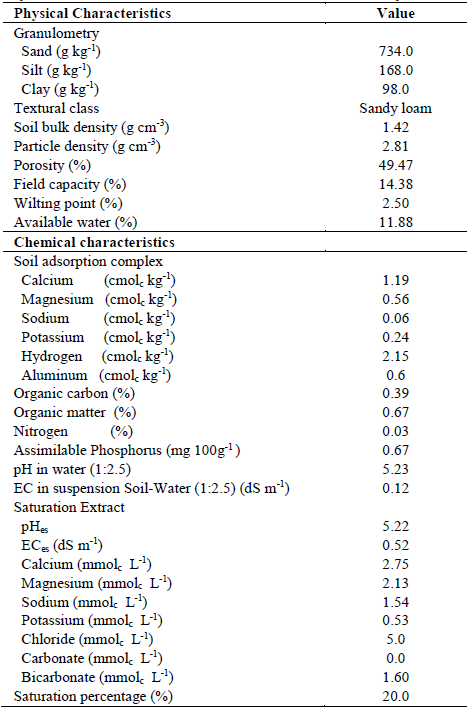
Analysis carried out in the Irrigation and Salinity Laboratory of the Center of Technology and Natural Resources (CTRN/UFCG)
Source: The authors
The results were evaluated using the Analysis of Variance (ANOVA), through the 'F' test at the level of p <0.01 and p <0.05 probability, and in the cases of significance, the Tukey test was performed at 0.05 probability level using the statistical software SISVAR 5.2 [11].
3. Results and discussion
According to the CAAP data, significant effects were verified at a probability of 0.01 for the salinity factor in all intervals evaluated (Table 2), however, for the cultivar factor there was no significant effect at any time of evaluation, as well as for the interaction salinity versus cultivar (S x C).
Table 2 Summary of the ANOVA and mean values of accumulated water consumption by plants (CAAP), of sunflower cultivars irrigated with waters of different electrical conductivities (ECw).
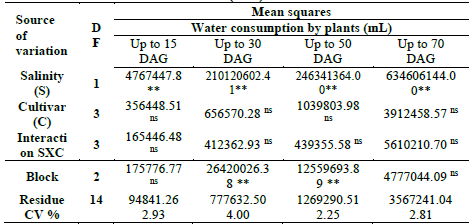
*and ** significant at 0.05 and 0.01 probability, respectively. ns - not significant by the "F" test. DF= degrees of freedom, CV= coefficient of variation, DAG= days after germination.
Source: The authors
A decrease in water consumption by the plants when the non-saline S1 condition (ECw = 0.6 dS m-1) was changed to the S2 salt (ECw = 3.0 dS m-1) can be observed, reducing to 8.12, 23.69, 33.66 and 39.00% at 15, 30, 50 and 70 DAG, respectively (Fig. 1). In general, there was a tendency to reduce water consumption (mainly at the highest level), as the cycle progressed. The osmotic effect of salinity was also observed, since with the increase in ECw, there was a decrease in water consumption by the plant, harming the growth and development of the crop [12]. When studying different sunflower cultivars under conditions of salt stress, the same authors verified that the water consumption decreases with the decrease in osmotic potential of the saline solutions.

Source: The authors * Same letters in the same DAG do not differ from each other at 0.05 probability by the Tukey test.
Figure 1 Accumulated water consumption of the plants at 15, 30, 50 and 70 days after germination (DAG), irrigated with two saline waters.
The results obtained in this study coincide with those found by [13 and 14], who confirm that the increase in the concentration of salts in the soil tends to significantly reduce the water consumption levels of plants.
For the variable volume of water drained in the soil (Table 3), significant effects were observed (p <0.01 and <0.05) in the factor levels of irrigation water salinity, in all stages evaluated except for the 30 DAG. For the cultivar factor and the S x C interaction, there was no significant effect at any time of evaluation.
Table 3 Summary of the ANOVA and means for the volume of water drained in the soil (Vds), under sunflower cultivars irrigated with waters of different electrical conductivities (ECw).
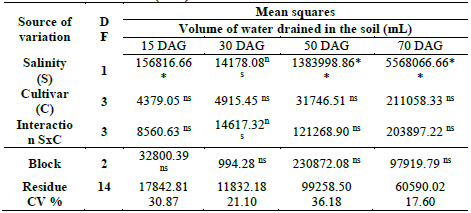
*and ** significant at 0.05 and 0.01 probability, respectively. ns - not significant by the "F" test. DF= degrees of freedom, CV= coefficient of variation, DAG= days after germination.
Source: The authors
Fig. 2 reveals that the decrease was 31.48 and 43.24% at 15 and 50 DAG, respectively, for the volume of water drained (Vds), when there was an increase in ECw.
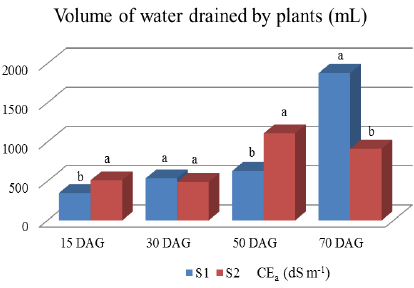
Source: The authors * Same letters in the same DAG do not differ from each other at 0.05 probability by the Tukey test.
Figure 2 Volume of water drained in the soil at 15, 30, 50 and 70 DAG, irrigated with two saline waters.
The results obtained in the present study show that the excess of salts affect the growth of the plants, since there is a decrease in the absorption of water by the crop. According to [15] the excess of salts, accumulated in the root zone, hinders the absorption of water by the plant due to the reduction of water available in the soil.
According to the ANOVA summary for the variable leaching fraction, there was a significant effect at p <0.01 for the factor salinity levels of irrigation water in all stages evaluated, with the exception of 70 DAG (Table 4). For the cultivar factor and the S x C interaction, there was no significant effect.
Table 4 Summary of the ANOVA and means for the leaching fraction (LF) of sunflower cultivars irrigated with waters of different electrical conductivities (ECw).
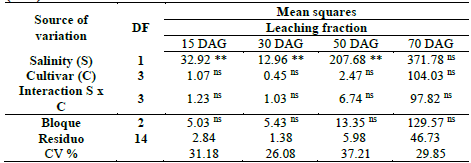
*and ** significant at 0.05 and 0.01 probability, respectively. ns - not significant by the "F" test. DF= degrees of freedom, CV= coefficient of variation, DAG= days after germination.
Source: The authors
The LF showed declines of 35.56, 28.00, 61.83 and 29.33% in the saline condition (S2) in relation to the non-saline - S1 (0.6 dS m-1), for the periods of 15, 30, 50 and 70 DAG, respectively (Fig. 3).
The salts accumulated in the root zone (when in excess) make it difficult to extract water from the plant. This can be observed at 70 DAG, by analyzing the volume of drained water (Fig. 2) and the LF applied, since even though the leaching fraction is higher in water S2 (Fig. 3), the drained volume was much lower (Fig. 2).

Source: The authors * Same letters in the same DAG do not differ from each other at 0.05 probability by the Tukey test.
Figure 3 Leaching fraction at 15, 30, 50 and 70 DAG, irrigated with two saline waters.
The results obtained in this work agree with that found by [16, 17 and 18] who, when studying the application effect of the LF in several crops in different environments, observed significant increases in the productivity and growth of the plants when they were irrigated with saline waters, subjected to different fractions of leaching.
Regarding the electrical conductivity of the drainage water (ECd) (Table 5), a significant effect was verified for the factor levels of irrigation water salinity in all periods evaluated, however, for the cultivar factor there was no significant effect at 0.01, as well as for the interaction S x C.
Table 5 Summary of ANOVA and means for the electrical conductivity of drainage water (ECd) of sunflower cultivars irrigated with waters of different electrical conductivities (ECw).

*and ** significant at 0.05 and 0.01 probability, respectively. ns - not significant by the "F" test. DF= degrees of freedom, CV= coefficient of variation, DAG= days after germination.
Source: The authors
The electrical conductivity of the drainage water (ECd) increased with the increase in the electrical conductivity of the irrigation water (Fig. 4). This fact is due in part to the reduction of the osmotic potential of the solution at higher salinity levels. The electrical conductivity of the water drained from the pots irrigated with S2 was 3.67, 3.52, 2.89 and 3.82 times higher compared to when it was irrigated with S1 on 15, 30, 50 and 70 DAG, respectively. The accumulation of salts in the soil depends on the quality of the irrigation water, on the physical properties of the soil and above all on the conditions of drainage and water and salt balance in the subsoil [19]. It can be observed in Figures 1, 2 and 3 that the cultivars have lower consumption, lower drainage and a fraction of leaching greater at 30 and 70 DAG. In those times the plants consumed less, and there was likely difficulty in extracting the water stored in the soil, as a consequence of a reduction in the availability of water for the plants.

Source: The authors * Same letters in the same DAG do not differ from each other at 0.05 probability by the Tukey test.
Figure 4 Electrical conductivity of water drained at 15, 30, 50 and 70 days after germination (DAG), irrigated with two saline waters.
Table 6 shows a significant effect at 0.01 probability level for the factor of salinity levels of irrigation water in all periods evaluated for the concentration factor, however, for the cultivar factor no significant effects were found in any evaluation period with the exception of 70 DAG, the same occurred in the S x C interaction.
Table 6 Summary of ANOVA for the concentration factor (CF) of sunflower cultivars irrigated with waters of different electrical conductivities (ECw).

*and ** significant at 0.05 and 0.01 probability, respectively. ns - not significant by the "F" test. DF= degrees of freedom, CV= coefficient of variation, DAG= days after germination.
Source: The authors
The variable concentration factor decreased with the increase in the salinity of the irrigation water from 0.6 to 3.0 dS m-1 (Fig. 5), with reductions of 26.76, 29.54, 42.26, 23.64% for the evaluated periods of 15, 30, 50 and 70 DAG, respectively. This is probably due to the precipitation of a fraction of the salts.

Source: The authors * Same letters in the same DAG do not differ from each other at 0.05 probability by the Tukey test.
Figure 5 Concentration factor - CF at 15, 30, 50 and 70 days after germination (DAG), irrigated with two saline waters.
Regarding the average values of the variable CF, with respect to the splitting of its significant interaction between the S x C factors (Table 7), different results were obtained in the Catissol 01 and Multissol cultivars. When increasing the salinity of the irrigation water, mean values of 8.92 and 9.36 were registered for salinity 0.6 dS m-1, respectively.
Table 7 Means of the variable factor of concentration (CF) of sunflower cultivars irrigated with waters of different electrical conductivities (ECw) at 70 DAG.

Means referenced with the same lowercase letter in the column and uppercase in the line, do not differ from each other by the Tukey test at 0.05 probability level.
Source: The authors
According to the data in Table 7, the splitting of the cultivar within the salinity levels studied caused a significant effect on the results, where the cultivars Catissol 01 and Multissol differed statistically from the cultivar Helio 863 using ECw of 0.6 dS m-1. In the case of the ECw water of 3.0 dS m-1, the cultivars Embrapa 122-V2000 and Helio 863 differed statistically from the cultivars Catissol 01 and Multissol.
Conclusions
There was a reduction in water consumption of sunflower cultivars irrigated with saline water.
Irrigation with saline water resulted in a greater volume of drained water in all sunflower cultivars.
With the increase in irrigation water salinity, the value of the LF increased in addition to the electrical conductivity of the drained water.















